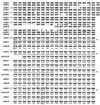Complete genomic sequence of the human ABCA1 gene: analysis of the human and mouse ATP-binding cassette A promoter
- PMID: 10884428
- PMCID: PMC16657
- DOI: 10.1073/pnas.97.14.7987
Complete genomic sequence of the human ABCA1 gene: analysis of the human and mouse ATP-binding cassette A promoter
Erratum in
- Proc Natl Acad Sci U S A 2002 Jan 22;99(2):1098
Abstract
The ABCA1 gene, a member of the ATP-binding cassette A (ABCA1) transporter superfamily, encodes a membrane protein that facilitates the cellular efflux of cholesterol and phospholipids. Mutations in ABCA1 lead to familial high density lipoprotein deficiency and Tangier disease. We report the complete human ABCA1 gene sequence, including 1,453 bp of the promoter, 146,581 bp of introns and exons, and 1 kb of the 3' flanking region. The ABCA1 gene spans 149 kb and comprises 50 exons. Sixty-two repetitive Alu sequences were identified in introns 1-49. The transcription start site is 315 bp upstream of a newly identified initiation methionine codon and encodes an ORF of 6,783 bp. Thus, the ABCA1 protein is comprised of 2,261 aa. Analysis of the 1,453 bp 5' upstream of the transcriptional start site reveals multiple binding sites for transcription factors with roles in lipid metabolism. Comparative analysis of the mouse and human ABCA1 promoter sequences identified specific regulatory elements, which are evolutionarily conserved. The human ABCA1 promoter fragment -200 to -80 bp that contains binding motifs for SP1, SP3, E-box, and AP1 modulates cellular cholesterol and cAMP regulation of ABCA1 gene expression. These combined findings provide insights into ABCA1-mediated regulation of cellular cholesterol metabolism and will facilitate the identification of new pharmacologic agents for the treatment of atherosclerosis in humans.
Figures





References
-
- Fredrickson D S, Attrocchi P H, Avioli L V, Goodman D S, Goodman H C. Ann Intern Med. 1961;55:1016–1031.
-
- Assmann G, von Eckardstein A, Brewer H B., Jr . In: The Metabolic and Molecular Basis of Inherited Disease. Scriver C R, Beaudet A L, Sly W S, Valle D, editors. New York: McGraw–Hill; 1995. pp. 2053–2072.
-
- Rust S, Rosier M, Funke H, Real J, Amoura Z, Piette J C, Deleuze J F, Brewer H B, Jr, Duverger N, Denefle P, Assmann G. Nat Genet. 1999;22:352–355. - PubMed
-
- Brooks-Wilson A, Marcil M, Clee S M, Zhang L-H, Roomp K, van Dam M, Yui L, Brewer C, Collins J A, Molhuizen H O F, et al. Nat Genet. 1999;22:336–345. - PubMed
-
- Bodzioch M, Orso E, Klucken J, Langmann T, Bottcher A, Diederich W, Drobnik W, Barlage S, Buchler C, Porsch-Ozcurumez M, et al. Nat Genet. 1999;22:347–351. - PubMed
Publication types
MeSH terms
Substances
Associated data
- Actions
- Actions
LinkOut - more resources
Full Text Sources
Other Literature Sources
Molecular Biology Databases

